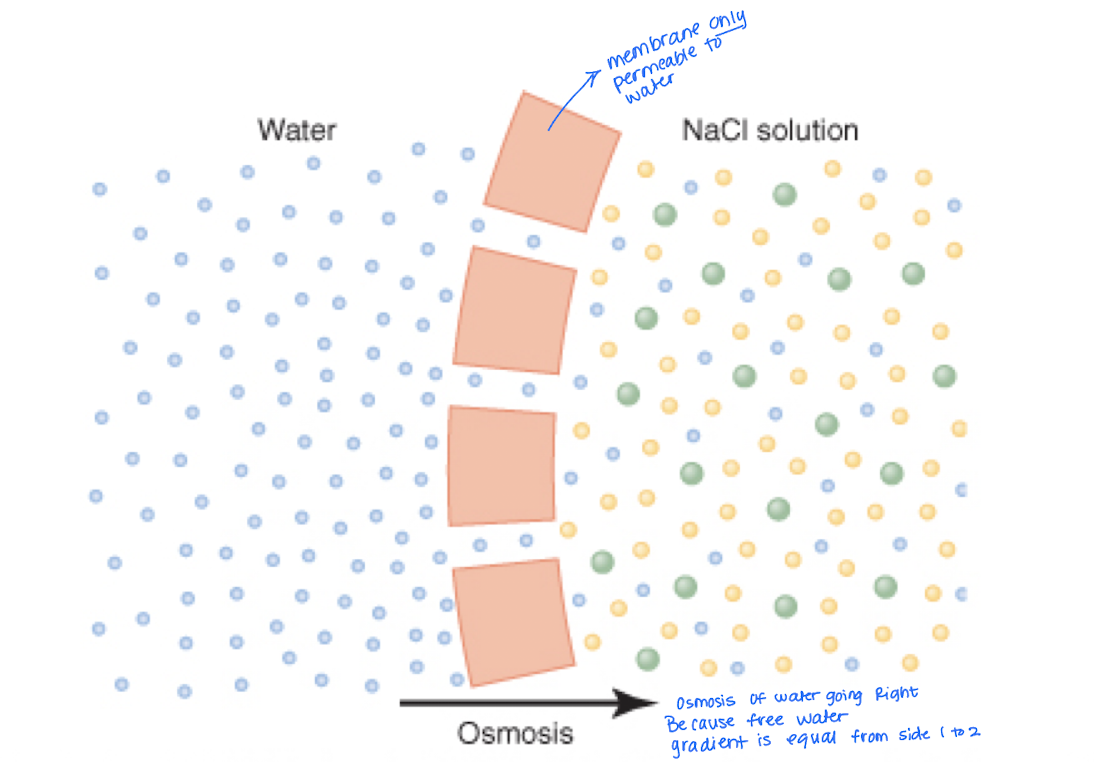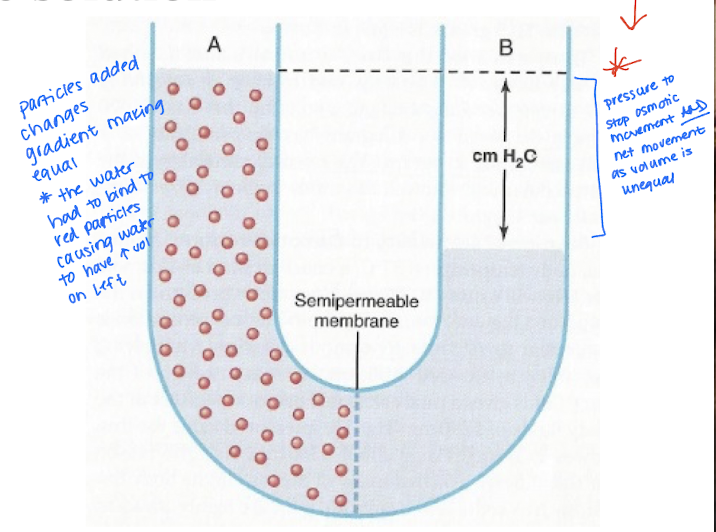Ch. 4 Transport of Substances Through the Cell Membrane
1/33
Earn XP
Description and Tags
Flashcards reviewing the transport of substances through the cell membrane, covering diffusion, active transport, and related concepts.
Name | Mastery | Learn | Test | Matching | Spaced |
|---|
No study sessions yet.
34 Terms
What is the function of the lipid bilayer in the cell membrane?
It acts as a barrier against water movement and water-soluble substances between the inside and outside of the cell.
What role do protein molecules play in the cell membrane?
They serve as alternate pathways for molecules that cannot directly pass through the lipid bilayer.
What is the difference between channel proteins and carrier proteins?
Channel proteins create watery spaces for molecules to pass through, while carrier proteins bind to molecules and transport them across the membrane.
Define simple diffusion.
Continual movement of molecules in liquids or gases
T/F: Simple diffusion interacts with carrier proteins
False
What factors determine the rate of simple diffusion through a membrane?
Concentration difference
velocity of movement
number/size of openings in the membrane
What is facilitated diffusion?
Diffusion that requires the interaction of a carrier protein with the substance being transported.
What is the key property that allows substances to diffuse through the membrane?
how does oxygen move across the membrane?
CO2?
Lipid solubility
Needs a high pressure gradient
Diffuses with low gradient
How is the rate of simple diffusion affected as the concentration gradient increases?
Positive correlation, rate of diffusion increases
Describe protein channels
selectively permeable that allow specific molecules through membrane
channels are open or closed by “gates”
has specific characteristics such as electrical charge inside
ex: Na/K pump, Ca pump
When looking at sodium channels on the cell membrane, why is the sodium channel outside the cell (ECF)?
The sodium channel is located outside the cell due to the higher concentration of sodium ions in the extracellular fluid (ECF) compared to the intracellular fluid, facilitating sodium's movement into the cell.
How are protein channels opened and closed?
Through "gates" controlled by voltage (voltage gating) or ligand binding (ligand gating).
In voltage a specific voltage must be reached for the gate to open. Exact voltage - tied to all or none concept
Describe voltage gating in protein channels.
The gate is controlled by the electrical potential across the cell membrane.
Describe ligand gating in protein channels.
The gate is controlled by the binding of a molecule (ligand) to the channel protein.
What happens to the rate of facilitated diffusion as the concentration of the transported substance increases?
Why?
What about Simple diffusion?
It approaches Vmax, the maximum rate of transport, Increases and then levels out
Transport proteins become oversaturated and do not have available binding sites for the molecule slowing down diffusion.
Facilitated diffusion branches to carrier mediated diffusion meaning binding is needed / related to Vmax
Keeps increasing
What factors determine the net rate of diffusion?
Concentration gradient and electrical gradient
Eventually, the concentrations will balance each other out stopping NET movement but not overall diffusion
Define Osmosis
A form of diffusion; process of net movement of water caused by a concentration gradient
In osmosis, the net movement (of water) is typically zero. How do we know net is zero?
If outside of zero we can see the cell shrink or swell
Explain Osmosis in relation to Creatine intake.
.Creatine draws water into the muscle cells through osmosis causing muscles to swell as water follows along the concentration gradient.
Similar effect occurs with sodium and the cell

Explain the Free Water Gradient
The free water gradient refers to the difference in the concentration of free water molecules across a semipermeable membrane, influencing the direction of water movement by osmosis, typically from a region of higher free water concentration to a region of lower free water concentration.
Define Osmotic Pressure
The exact amount of pressure required to stop osmosis. There is no net movement but movement is still present
In the “loop” filled with water without particles such as Na+ the water will be level reaching both points A and B. Once the red particles are added, water will move across the semipermeable membrane along the concentration gradient till equilibrium is reached. The loss of water on side B is the defining pressure needed stop osmostic movement and net movement.
The water had to bind to the particles causing water to have a higher volume on the left

Define Osmolality and Osmolality
Osmolality
The concentration of a solution in terms of the number of particles per kilogram of water.
Osmolarity
osmoles per liter of solution - is the number of particles per liter of solution which produces a certain osmotic pressure.
where diffusion stops
What is active transport?
The movement of substances "uphill" against a concentration, electrical, or pressure gradient.
2 types
Primary Active transport
Energy is derived directly from ATP
ex: Na and K
Secondary Active transport
Energy is derived secondarily, usually from concentration gradient created from primary
Which form of Active Transport uses carrier proteins where binding is required?
a. Primary Active Transport
b. Secondary Active Transport
c. Neither
d. Both
d. Both
Describe the function of the sodium-potassium pump.
Form of Primary Active Transport - for impulse transmission
It pumps sodium out of the cell and potassium into the cell, maintaining concentration and electrochemical gradients.
What is the sodium-potassium pump? What are the protein features?
Functions: helps set concentration gradient, electrical gradient, and controls cell volume
Cell swelling is automatically activated by pump
Pump is electrogenic - causing electrical potential across the membrane (more negative inside cell)
Features: 3 receptor sites for sodium (inside), 2 receptor sites for potassium (outside), and ATPase inside
Why is the sodium-potassium pump considered electrogenic?
It creates an electrical potential across the membrane by moving more sodium ions out than potassium ions in, resulting in a negative charge inside the cell
Describe the Calcium pump
Primary active transportthat transports calcium ions out of the cell to regulate cellular calcium levels
Consists of two pumps: one pumps Ca+ to the exterior of the cell, second pumps into the SR (from the cytosol) or Mitochondria
Where does the primary active transport of hydrogen occur?
Gastric glands of the stomach (parietal cells)
increased to secrete hydrocholric acid for digestion
late distal tubules and cortical collecting ducts of the kidneys.
rid body of hydrogen ions (from blood into urine)
Describe the two types of Secondary Active Transport
Co-transport
the energy gradient of sodium causes another substance to be transported to the interior of the cell along with the sodium. (Use binding site)
Both molecules move in the same direction
Counter-Transport
the energy gradient of sodium causes another substance to be transported out of the cell while sodium moves in. Both molecules move in opposite directions.
there is one receptor outside and one inside and both substances bind to the receptors for a conformational change
What is co-transport?
A type of secondary active transport where the energy gradient of sodium causes another substance to be transported to the interior of the cell along with the sodium.
ex: sodium-glucose
occurs in the intestinal tract and renal tubules
What is counter-transport?
A type of secondary active transport where sodium moves to the interior of the cell while another substance moves to the exterior.
Ex: Sodium-calcium
occurs in almost all tissues
Ex: Sodium-hydrogen
occurs in proximal tubules of kidneys
key to hydrogen ion control in body fluids
What are two ways we can get Ca to move?
with ATP (Calcium pump)
Counter transport - used when ATP with not available
Examples of counter-transport.
Sodium-calcium and Sodium-hydrogen.